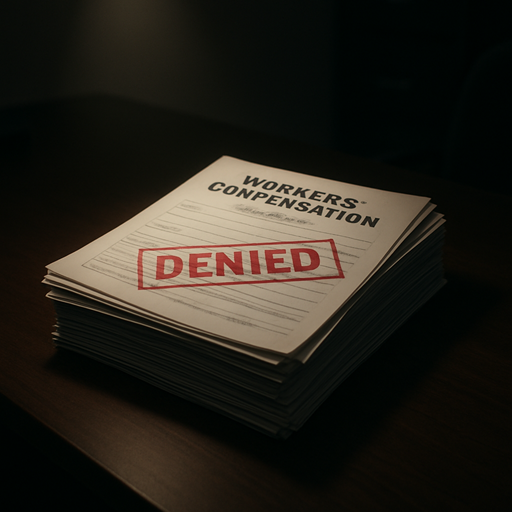GUEST PIECE: The Failure of Utah's Workers' Comp System: A Personal Story
- thelineinfo

- Aug 5, 2025
- 4 min read
Updated: Nov 10, 2025
by Gary Diaz

EDITOR'S NOTE: This is Gary’s story. He’s spent over a year navigating Utah’s workers’ comp system. What follows is his account — both personal and researched — of how that experience unfolded.
Navigating life as a single parent while managing a job and attending school is difficult. Many workplaces do not accommodate single parents. I wanted to provide for my kids and spend quality time with them, so I sought a manageable job with good income.
I thought FedEx would be the right fit, as I had worked there before and believed it would be easy to return. I was hired almost immediately because of my previous experience. I’m aiming to compete on the USA Olympic wrestling team, so the new system they had that allowed employees to pick up and swap shifts made it easy for me to work there.
However, shortly after I was hired in May 2024, a manager struck me from behind while I was handling a package. It caused a stinging pain in my lower left leg. I sought medical care under workers’ comp, which revealed disc protrusions on my sciatic nerve. After initial examinations, I opted for conservative treatment, including therapy and steroid injections, but declined surgery due to side effects.
I sought a second opinion from Dr. Qing-Min Chen, an independent medical examiner from Colorado hired by the insurance company. He determined that my injury was not work-related and diagnosed it as degenerative disc disease. In contrast, Steve Mayer, a nurse practitioner specializing in neurosurgery and physical medicine and rehabilitation at the Ogden Clinic, said my injury was work-related and diagnosed it as a lumbar disc herniation.
Those conflicting diagnoses made me question whether this was bigger than just my case, so I started digging and found that there are plenty of claims that line up with mine.
A 2009 study in "The Spine Journal" found that low back pain comprises about 16% of workplace compensation claims and nearly 33% of total claims costs. At least 5% of those cases don't respond to conservative therapy, leading many injured workers to consider surgery.
The research told me I wasn’t alone. But knowing that didn’t make the state’s decision any easier to live through.
When workers’ comp learned of my situation, they dropped my case. That was a huge blow, as I was already stressed with raising my two kids on top of coaching wrestling and work. I was forced to apply for state aid, which I found to be a lengthy process involving extensive paperwork, lengthy phone calls, and endless bureaucracy.
The entire process has been painfully slow, with the injury occurring in June 2024, followed by a deposition in April and further litigation that took place in July with the Utah State Labor Commission. It feels like an excessively long wait—almost 13 months—to hold FedEx accountable for their negligence.
It appears that employees injured on the job in Utah face a lengthy litigation process that hurts them more than helps. From what I’ve gone through, it’s clear the system isn’t built to support conservative treatments. It pushes injured workers straight to surgery — whether that’s what’s best for them or not.
This prolonged process led me to experience emotional and mental distress. It’s also made my pain and discomfort worse as a result. What’s shocking is that this ties in to what researchers have found in the past regarding cases like mine.
The aforementioned study, which was led by Utah State University professor Scott DeBerard, reported that certain factors before surgery can predict poor outcomes for lumbar fusion in Utah. These factors include having had multiple previous back surgeries, lower income at the time of injury, being older, involvement in litigation, alcohol use, and experiencing depression.
Another study from 2012 found that outcomes for lumbar fusion surgeries in Utah worsened within a ten-year period up to the time of the study, despite advancements in medical technology. While it didn’t say that compensated workers couldn’t benefit from lumbar fusion, it emphasized the need for medical providers and surgeons to exercise caution when recommending such treatment for injured workers.
Ultimately, companies appear to be taking advantage of workers by dragging out the litigation process. Instead of helping workers, the State of Utah is making it costlier and cumbersome to get necessary treatments that would help improve lives.
The one treatment that could’ve helped me was made practically impossible to get because of the long and drawn out litigation process. With research showing that most workers' comp claims are back pain-related and that most of the surgeries that are offered don’t help much of the time, it physically made things go from bad to worse.
And to top it all off, my claim was denied along the way, like I wasn’t already feeling crushed by the entire situation.
What needs to happen is that companies and states need better coordination, along with federal oversight, to make this process bearable for people.
My case shouldn’t have slipped through the cracks. If there were real oversight — if these outcomes were tracked and taken seriously — maybe I wouldn’t still be fighting for treatment that never should have been denied.
This system doesn’t just fail workers — it punishes them for being injured. Without real coordination between companies, states, and federal agencies, cases like mine will keep slipping through. And we’ll keep paying for it — with our health, our time, and our futures.
The views expressed in this piece are those of the contributor and do not necessarily reflect those of TheLine.Info.









Comments